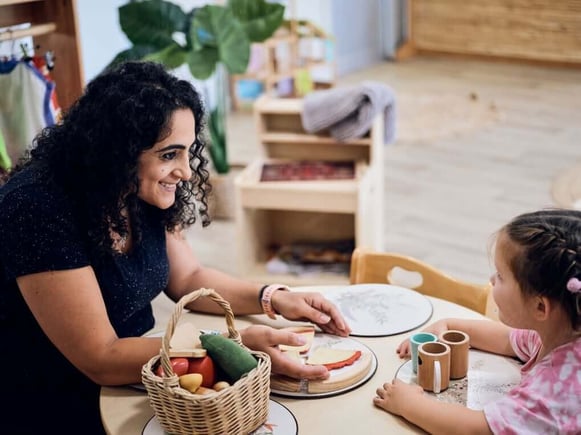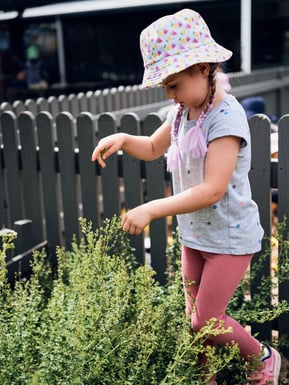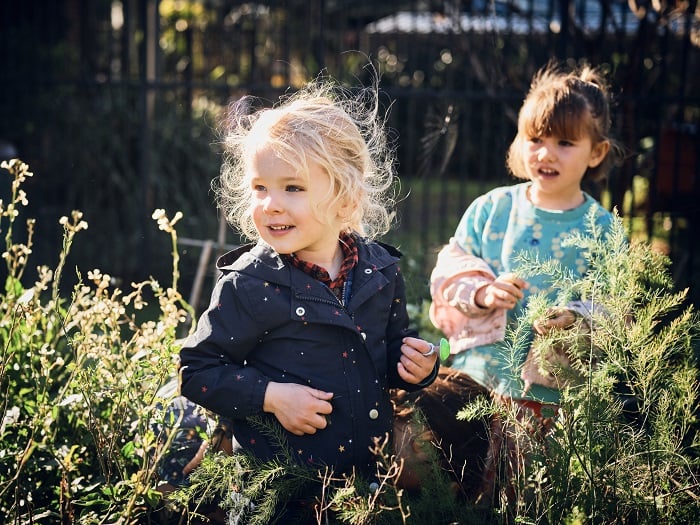On this page
Why Gardening Is Beneficial To Children
How Does Gardening Help A Child Develop?
How To Get Children Interested in Gardening
Gardening Activities For Children
Relationships Between Living Things and Children
How it Benefits Your Child's Education
Gardening Within Child Care Curriculums
Introduction:
There’s a reason why people enjoying gardening when they retire. The fresh air, connecting with nature and even growing your own food. But the benefits of gardening aren’t just reserved for the elderly. Gardening has incredible benefits for children’s health and development as well as planting the seed of a love of the outdoors.
It’s time to dust off the gardening gloves and fill the watering can to get the children busy in the garden. Here’s why and how to do it.
Why Gardening Is Beneficial To Children
It’s messy and dirty and children love it. Gardening brings so many benefits for children, like these ones listed below.
Develops Motor Skills
Gardening isn’t a static activity. It’s dynamic and involves lots of different movements that help to develop both fine and gross motor skills.
Fine motor skills
Holding a small shovel or picking up a tiny seed to plant it in the ground are both examples of fine motor activities. Even grasping onto a cherry tomato to pick it from the plant or picking up a worm that you’ve found in the soil are helping to develop fine motor skills.
Gross Motor Skills
Along with the fine movements that come with gardening, there are also many opportunities to use the big muscle groups. Lifting and carrying a water can, digging a hole or stretching to reach to the back of the garden bed all use upper and lower body muscles.
Encourages Healthy Eating
Gardening teaches children about growing their own food and encourages them to try different fruit and vegetables. We all know that eating a strawberry picked from the garden tastes so much better than one you’ve bought from the supermarket.
They’ll also feel a great sense of pride if you use the vegetables or herbs they’ve grown in the meals you cook.
Improves Cognitive Abilities And Social Skills
Gardening doesn’t bring instant gratification. You plant a seed… and then wait for it to grow. It can be weeks before you can enjoy the fruits of your labour. From this, children get invaluable lessons in patience. They also learn listening skills and how to follow instructions.
While gardening can be great to do as a solitary activity, when children garden with siblings or their peers, it also helps them to develop their interpersonal skills.
Minimises Stress
There’s something about connecting with nature. Being in the fresh air. Enjoying the sunshine. Gardening is relaxing. And it can help children to reduce their stress, or to use gardening as a way to reduce their stress as their progress through life.
Improves STEM Skills
Gardening relies on a certain level of scientific and mathematical reasoning. Measuring the space between plants or choosing the perfect spot for a plant based on the amount of sun it needs are both STEM-related skills.
Plants are living things that need water and nutritious soil to grow. So are the insects that live amongst the plants. Gardening is an opportunity to learn about the life cycle, another important STEM skills.
Provides Physical Activity
Think of all the lifting, digging, bending and reaching you do while you’re working in the garden. It’s a good way for children to get active and exercise different muscle groups that they wouldn’t normally through their regular active play.
Positively Impacts Psychological Wellbeing
Not only is gardening good for mood and stress management, it can also be beneficial for overall psychological wellbeing. It’s an activity that many adults will use as a form of self-care or “gardening therapy”. Children are no different!
How Does Gardening Help A Child Develop?
In addition the benefits of gardening with children, there are a large number of ways in which gardening helps children to develop.
- Responsibility: Gardening isn’t a one-off activity. Children learn to tend to their plants and be accountable for making sure they are watered and have everything they need to grow.
- Self-confidence: When children see their plants grow and can enjoy food that they’re grown themselves, it does wonderful things for their self-esteem as they develop self-confidence.
- Discovery: There is so much for children to learn in the garden. From nature to nutrition, the garden is a brilliant classroom for learning about the circle of life.
- Love of nature: In the garden, children learn about caring for the environment and why it’s important. They develop a love of nature that will stay with them throughout their entire life.
- Health and nutrition: What better way to learn about healthy eating than going right to the source? By gardening with children, you set them up for a lifetime of healthy habits.

How To Get Children Interested In Gardening
The benefits of gardening are clear. But that doesn’t mean your child is necessarily interested in picking up tools to get their hands dirty in the garden. There’s a few simple things you can do to pique their interest.
- Keep it simple. You don’t need to work in the whole garden straightaway. Start with a single pot or small patch of dirt. You might not even do any planting straightaway. Instead you could make mud pies or just dig in the dirt.
- Use the right tools. Children need lightweight tools that they can easily manage. If you use your regular gardening tools, they’ll likely be too heavy or large for your child to grasp and use.
- Get creative. If your child isn’t interested in gardening, set up a worm farm or add a scarecrow to the garden. This might be the introduction they need to turn into a green thumb.
- Encourage their ideas. If your child has ideas about how they want to set up the garden or the plants to include, listen and encourage their ideas.
- Make it interesting. Plant a variety of different plants such as flowers, climbing vines or your child’s favourite vegetables.
As fun and beneficial gardening is for children, garden safety is also really important. There are different risks and hazards to beware of in a garden setting. Here are some to consider.
Swimming Pool Safety
If you have a swimming pool, be sure that the pool gate is compliant with safety standards. Also, don’t leave furniture near the pool fence that your child could use to climb on to open the pool gate. Never leave the pool gate open.
Remember that a child can drown in as little as 5 cm of water so even paddling pools can be a drowning hazard. Paddling pools should be emptied as soon as play is over.
Children should always be supervised when in or around polls, even if the water is only very shallow.
Safely Store Garden Tools
Gardening tools can have lots of sharp and pointy edges that could cause injury in the wrong – little – hands. Keep them out of reach, along with power tools.
You can also opt for child-sized gardening tools that are easier for little hands to use. Children should still be supervised while using them but they are often a safer option.
Decrease The Risk Of Falls And Trips
Large sticks, tools and even tree roots can all be trip hazards in the backyard. Think about the layout of your garden so there’s still room to run around and play without bumping into planter boxes or the like.
For any trees or bushes, prune them regularly to avoid injuries from running into branches.
Understanding The Plants In Your Garden
Some plants look beautiful but are actually poisonous if ingested. While that might not be a problem for adults, children are much more likely to lick a plant or eat a leaf to see what it tastes like!
Some children may also be allergic to certain plants or grasses. Before you choose the plants for your garden, check that they’re safe for children.
Sun Protection
It goes without saying that anytime you’re outdoors, you should always be sun safe. Avoid gardening in the middle of the day when the sun is hottest and always wear a hat and sunscreen.
Appropriate Clothing
Gardening is dirty work and you will get messy… especially when you garden with children! Wear old clothes that you don’t mind getting dirty. For younger children, you might even want to put them in a waterproof splash suit or in gumboots, particularly if the ground is muddy after a bout of rain.
Hygiene Practices
Children should always wash their hands well with soap and water after they’ve been in the garden. You can also buy children-sized gardening gloves to wear while digging with their hands or using potting mix.
Take Breaks
Breaks are important for a couple of reasons. The first is that gardening is hard work and children can get tired easily. The second is that children can also bore of an activity if they do it for too long. Hold their interest by gardening in shorter bursts. Go outside to water your plants in the morning and then again to check on them in the afternoon.
Plant Selections For Children

Choosing the plants for your garden can be such a fun process. And it’s a great way to get your child involved. Rather than choosing random plants or sticking with what you know, spend a bit of time planning the plants for the garden.
For children, plants that grow quickly – such as vegetables and bright flowers – help to keep their interest levels up. A good way to think about your plant choices is through the five senses. Choose some plants that have interesting textural qualities, some that taste delicious, some that have amazing flower scents and some that have all the colourful petals. You can also add some plants that rustle or make other sounds.
Good examples of plants for children include:
- Succulents
- Strawberries
- Herbs (such as basil, mint and rosemary)
- Sweet peas
- Sunflowers
- Lavender
- Corn
- Bamboo
- Snapdragons
- Carrots
- Lettuce
- Cherry tomatoes
- Nasturtiums
- Beans
- Potatoes
- Pumpkin
Gardening With Different-Aged Children
The gardening capability of a toddler will vary quite a lot from that of a school-aged child. Their fine motor abilities, attention span and physical skills are very different! They’re not interested in the same things and also have different expectations of what gardening is like.
When gardening with younger children, you’ll need to supervise them more carefully and give them tasks that are suitable for their age and abilities, such as watering plants and planting seeds. Older children can work a little more independently and help out with some of the more physical tasks, like pruning, digging and carrying plants or soil.
Gardening Activities For ChildrenDepending on the age and interest level of your child, here are some activities they may be able to help with:
- Picking flowers, fruit and vegetables
- Collecting leaves that have fallen on the ground
- Pulling weeds
- Digging holes for planting
- Watering plants
- Placing food scraps in the compost
- Feeding the garden
- Repotting plants
- Removing dead flowers (i.e. deadheading)
- Preparing soil for planting
There are also a number of follow-up activities you can do with children that relate to what you do in the garden:
- Pressing flowers collected from the garden
- Craft activities with seeds, leaves and flowers
- Cooking with fruit, vegetables and herbs are grown in the garden
- Drawing plants or insects
- Painting or decorating pots to plant flowers in
Relationships Between Living Things and Children
When children learn about living things they start to develop empathy and broaden their worldview. They learn to be socially responsible and show respect for the environment as they build their connection to the world around them.
The lesson isn’t just that there are living things but that living things has needs. If plants don’t get enough sunlight or water, they won’t survive. Children learn to take responsibility for caring for plants and also the consequences of what happens when they don’t.
How it Benefits Your Child's Education
Through gardening, children are engaging all of their senses. They smell, touch, see, hear and taste. The motor skills they develop through digging and planting will help them with other fine motor activities like holding a pencil or using scissors.
Gardening also gives children a head start on the scientific and mathematical concepts that they’ll develop through their school years. Not to mention the benefits of spending time in the great outdoors and learning about healthy food! Less screen time, more green time.
Transitioning From Early Childhood Education To School Tips For Gardening With Children

So, how do you actually get started in the garden with your child? Here are a few tips to help:
- Start with a few pots and some seeds and go from there. Let your child grow with the idea of gardening!
- Once you have their interest, give them their own garden bed. It’s tempting to step in and take over but try to empower them to develop the skills they need. Younger children will need more help but they may surprise you with how quickly they learn.
- Talk about the plants you’ll grow before you even step foot in the garden. Talk about how you can grow your own vegetables and ask for their help to plan what you should plant.
- Rather than buying seedlings or established plants, start with seeds to teach your child about the life cycle of plants. They will learn more when they can see the whole process happening.
- Teach your child about garden safety so they develop good habits.
- Celebrate your successes by sharing your produce with friends and neighbours or making a special meal.
Gardening Within Child Care Curriculums
In a child care setting, we use gardening to teach children about the environment and to help the children build their social and emotional skills. We help the children to develop their sense of agency by empowering them to be accountable for caring for the garden. We teach children about healthy food by planting seasonal vegetables that they can taste as they pick them. We also teach STEM concepts such as learning about living things.
At Gowrie NSW, we support the children and families at our centres to explore different opportunities to extend their learning and relationships. We use gardening in our centres and can help you with tools, tips and ideas for gardening with your children at home.
Contact us to learn more about our early education and care centres.




.jpg)

